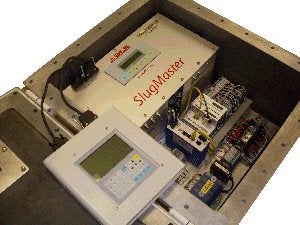
ABLE has successfully installed their SlugMaster® system to solve a challenging produced water application onboard the Talisman Clyde Platform.
Talisman Energy (UK) Ltd has been operating the Clyde Platform, situated in UKCS block 30/17b some 360km east of Dundee, since acquisition of the asset from BP Exploration in January 1997. It is a fixed platform on which there are facilities for drilling, production, accommodation and the associated utilities.
The Clyde Platform’s processing facilities separate production from a number of different reservoirs, exporting oil and gas via the Talisman Fulmar ‘A’ Platform to Teesside and St Fergus terminals.
To meet hydrocarbon in produced water regulations, it became necessary to meter the water discharge to sea and also seawater / produced water volumetric flow rate prior to being injected back into the well reservoir.
The produced water on Clyde – containing a degree of gaseous content – was a perfect application for the ABLE SlugMaster system. The SlugMaster system fully coped with the low back pressure observed downstream of the degasser vessel which was the defining cause of gas migrating out of solution.
The ABLE SlugMaster uses two ultrasonic flow-metering technologies and a smart PLC to intelligently choose which technology to use, based on the process conditions. Constant metering is achieved regardless of solids and gas contamination. The change over between the two metering technologies is calculated with unique mathematical software, which enables exceptional measurement accuracy.
The importance of this measurement and the SlugMaster system is apparent in the penalties invoked by the DECC (formerly DTI) on produced water contamination levels. An excerpt from the DTI trading standard scheme information states:
- If a permit holder fails by the date specified in rule 8.1(b) to surrender in respect of an offshore installation operated by him a number of allowances equivalent to the number of kilogrammes of dispersed oil in produced water certified in the verified annual return as having been discharged from that installation, that permit holder shall be liable to pay a civil penalty calculated in accordance with rule 10.3.
- If a permit holder’s registry account in respect of an offshore installation operated by him does not contain sufficient allowances to facilitate a reduction of allowances under Rule 6.4.9(c) or a withdrawal of allowances under rules 6.7 or 6.8, that permit holder shall be liable to pay a civil penalty calculated in accordance with rule 10.3.
- The civil penalty mentioned in rule 10.1 and 10.2 shall amount to £280 (two hundred and eighty pounds) per kilogramme of dispersed oil in produced water that is discharged in excess of allowances surrendered or deficient in the registry account.
Talisman metering specialist Baron Bennington, commented, "Environmental measurement legislation requires that operators are currently required to measure produced water volume to no greater than +/- 10% uncertainty. The elimination of any significant errors in attempting to do this is very important, as an over or under measure bias would mean we were saying we put more or less water into the sea than we actually did. As the oil content is referenced to water volume this would result in over or under reporting of oil discharged to sea."
To put it in to perspective, a small systematic bias in volume measurement on a site flowing 250,000 barrels per day into the sea would amount to a great deal over the course of a year.
The SlugMaster is now also available as a densitometer version for high gas entrainment applications. The densitometer version enables precision compensation of the gas volume in the liquid. Independent trials at the NEL shows that sub 1% accuracy is achievable with the densitometer model even into gas volume fractions of over 30% significantly reducing the over read of liquid volume caused by high levels of gas entrainment.

